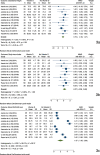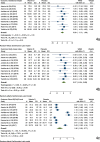Changes in anthropometric and blood 25-hydroxyvitamin D measurements in antenatal vitamin supplemented gestational diabetes mellitus patients: a systematic review and meta-analysis of randomized controlled trials
- PMID: 33663196
- PMCID: PMC8420744
- DOI: 10.4274/jtgga.galenos.2021.2020.0197
Changes in anthropometric and blood 25-hydroxyvitamin D measurements in antenatal vitamin supplemented gestational diabetes mellitus patients: a systematic review and meta-analysis of randomized controlled trials
Abstract
Objective: Gestation weight (GW), body mass index (BMI), and blood 25-hydroxyvitamin D [25(OH)D] level during pregnancy are important determinants of the gestational outcomes. This study aimed to study how these parameters vary between antenatal vitamin D recipients and non-recipients in gestational diabetes mellitus (GDM) patients.
Material and methods: The randomized controlled trials comparing these outcomes between vitamin D recipient and non-recipient GDM patients were searched in electronic databases (PubMed, Embase, and Scopus). The reviewed studies’ data were abstracted and critically appraised using the Cochrane tool. The estimation of the weighted mean difference for GW and BMI and standardized mean difference (SMD) for 25(OH)D levels occurred by juxtaposing the interventions meta-analytically (random-effect model). The statistical inconsistency was determined by Chi2 and I2 method. The statistical significance was estimated at p<0.05 and 95% confidence interval (CI).
Results: Eleven eligible trials (all Iran-based, except one), sourcing data from about 875 GDM patients, were reviewed. Overall, the risk of bias was low, except for selection and performance bias. On random-effect model meta-analysis, the 25(OH)D levels of the GDM patients favored the vitamin D recipients when compared to non-vitamin D (SMD 1.97, 95% CI: 1.06-2.88, p<0.001; I2 96.2%, p of Chi2 <0.001) and placebo (SMD 1.86, 95% CI: 0.95-2.77, p<0.001; I2 95.3%, p of Chi2 <0.001) recipients, respectively. On meta-regression, sample size was a predictor of the observed heterogeneity. For GW and BMI the interventions did not differ statistically significantly.
Conclusion: In GDM patients, antenatal use of vitamin D aids in the rise of blood 25(OH)D levels. However, vitamin D supplementation did not affect change in GW or BMI.
Keywords: Gestational diabetes; dietary supplement; vitamin D,.
Conflict of interest statement
Figures






Similar articles
-
Participant attrition and perinatal outcomes in prenatal vitamin D-supplemented gestational diabetes mellitus patients in Asia: A meta-analysis.World J Methodol. 2022 May 20;12(3):164-178. doi: 10.5662/wjm.v12.i3.164. eCollection 2022 May 20. World J Methodol. 2022. PMID: 35721245 Free PMC article.
-
Vitamin D Supplementation for the Outcomes of Patients with Gestational Diabetes Mellitus and Neonates: A Meta-Analysis and Systematic Review.Int J Clin Pract. 2023 Jan 14;2023:1907222. doi: 10.1155/2023/1907222. eCollection 2023. Int J Clin Pract. 2023. PMID: 36713951 Free PMC article.
-
The risk of morbidities in newborns of antenatal vitamin D supplemented gestational diabetes mellitus patients.Int J Health Sci (Qassim). 2020 Sep-Oct;14(5):3-17. Int J Health Sci (Qassim). 2020. PMID: 32952500 Free PMC article.
-
[Effect of vitamin D supplementation on gestational diabetes mellitus:a Meta-analysis].Wei Sheng Yan Jiu. 2019 Sep;48(5):811-821. Wei Sheng Yan Jiu. 2019. PMID: 31601326 Chinese.
-
Significance of Vitamin D on the Susceptibility of Gestational Diabetes Mellitus - A Meta-Analysis.Indian J Endocrinol Metab. 2019 Sep-Oct;23(5):514-524. doi: 10.4103/ijem.IJEM_184_19. Indian J Endocrinol Metab. 2019. PMID: 31803590 Free PMC article. Review.
Cited by
-
Efficacy trials comparing dosages of vitamin D and calcium co-supplementation in gestational diabetes mellitus patients require a methodological revamp.J Turk Ger Gynecol Assoc. 2022 Jun 1;23(2):120-121. doi: 10.4274/jtgga.galenos.2022.2021-9-23. Epub 2022 Mar 10. J Turk Ger Gynecol Assoc. 2022. PMID: 35266371 Free PMC article. No abstract available.
-
Participant attrition and perinatal outcomes in prenatal vitamin D-supplemented gestational diabetes mellitus patients in Asia: A meta-analysis.World J Methodol. 2022 May 20;12(3):164-178. doi: 10.5662/wjm.v12.i3.164. eCollection 2022 May 20. World J Methodol. 2022. PMID: 35721245 Free PMC article.
-
Vitamin D Supplementation for the Outcomes of Patients with Gestational Diabetes Mellitus and Neonates: A Meta-Analysis and Systematic Review.Int J Clin Pract. 2023 Jan 14;2023:1907222. doi: 10.1155/2023/1907222. eCollection 2023. Int J Clin Pract. 2023. PMID: 36713951 Free PMC article.
-
The effects of prenatal dietary supplements on blood glucose and lipid metabolism in gestational diabetes mellitus patients: A systematic review and network meta-analysis protocol of randomized controlled trials.PLoS One. 2022 May 3;17(5):e0267854. doi: 10.1371/journal.pone.0267854. eCollection 2022. PLoS One. 2022. PMID: 35503790 Free PMC article.
-
Vitamin D supplementation positively affects anthropometric indices: Evidence obtained from an umbrella meta-analysis.Front Nutr. 2022 Sep 7;9:980749. doi: 10.3389/fnut.2022.980749. eCollection 2022. Front Nutr. 2022. PMID: 36159504 Free PMC article.
References
-
- Quintanilla Rodriguez BS, Mahdy H. Gestational Diabetes. [Updated: 2019 Dec 23]. In: StatPearls [Internet] Treasure Island (FL): StatPearls Publishing; 2020. Available from: [Internet] https://www.ncbi.nlm.nih.gov/books/NBK545196/ - PubMed
-
- Xiong X, Saunders LD, Wang FL, Demianczuk NN. Gestational diabetes mellitus: prevalence, risk factors, maternal and infant outcomes. Int J Gynaecol Obstet. 2001;75:221–8. - PubMed
-
- Ferrara A. Increasing prevalence of gestational diabetes mellitus: a public health perspective. Diabetes Care. 2007;30(Suppl 2):S141–6. - PubMed
-
- Adam S, Rheeder P. Screening for gestational diabetes mellitus in a South African population: Prevalence, comparison of diagnostic criteria and the role of risk factors. S Afr Med J. 2017;107:523–7. - PubMed
LinkOut - more resources
Full Text Sources
Other Literature Sources
